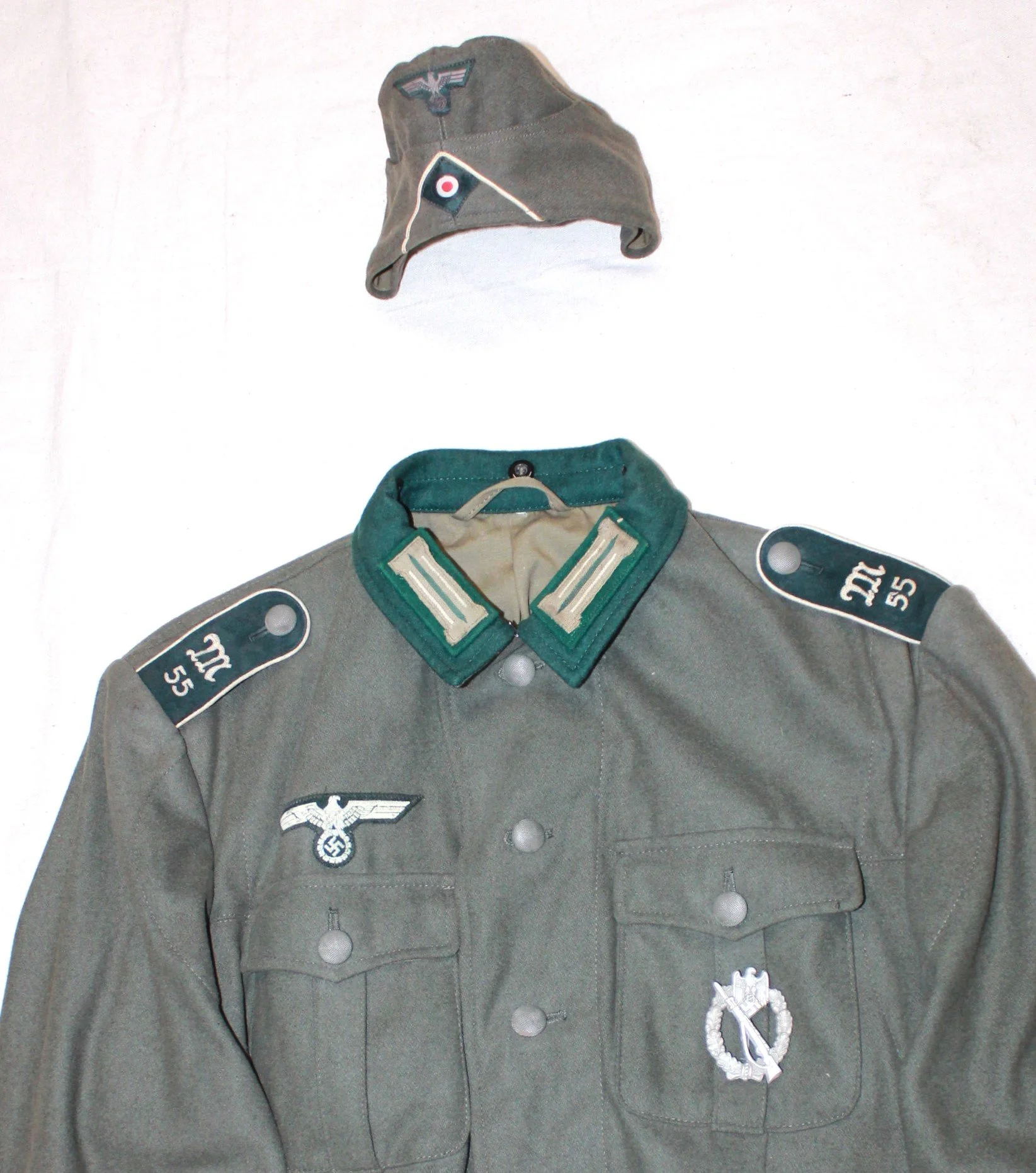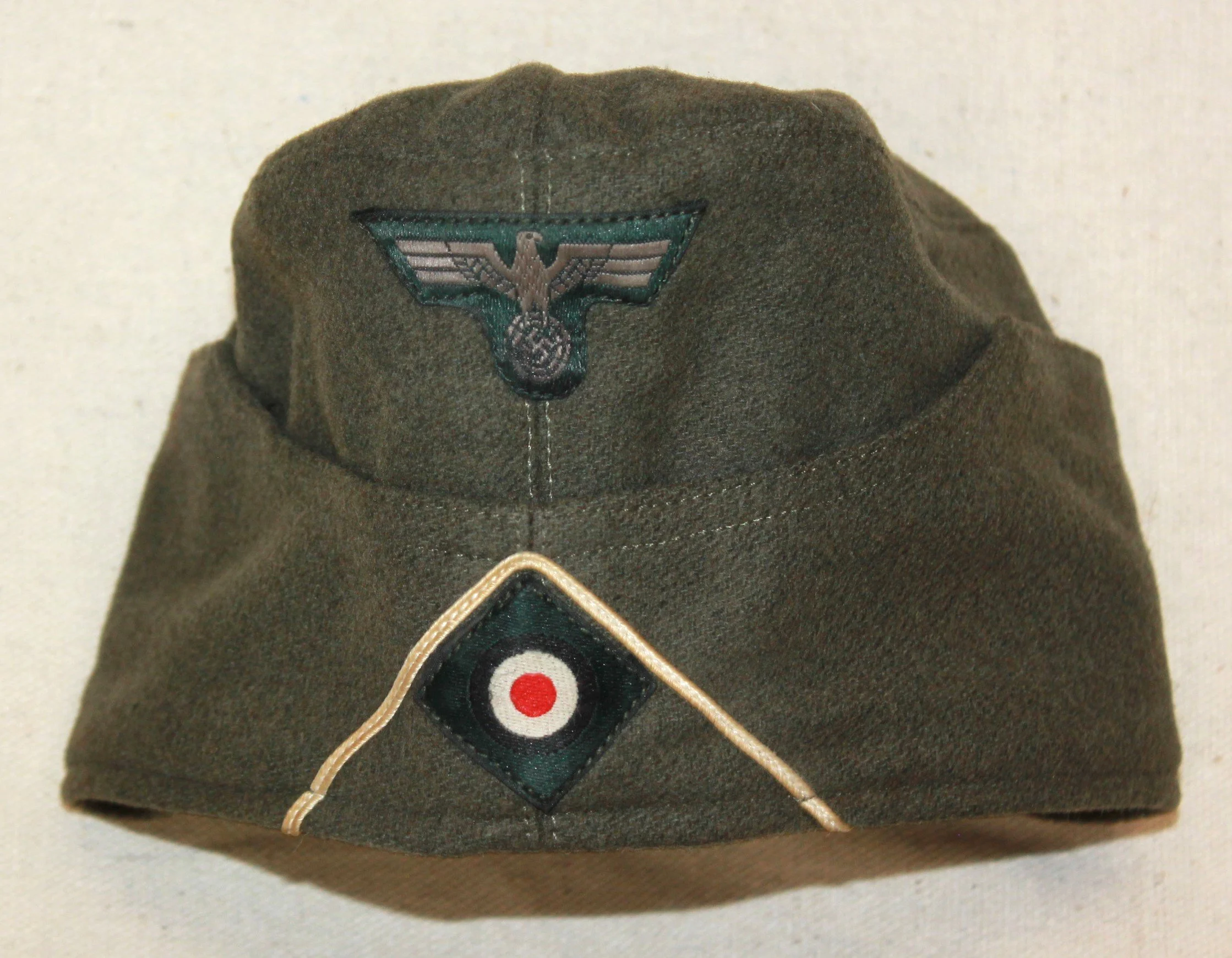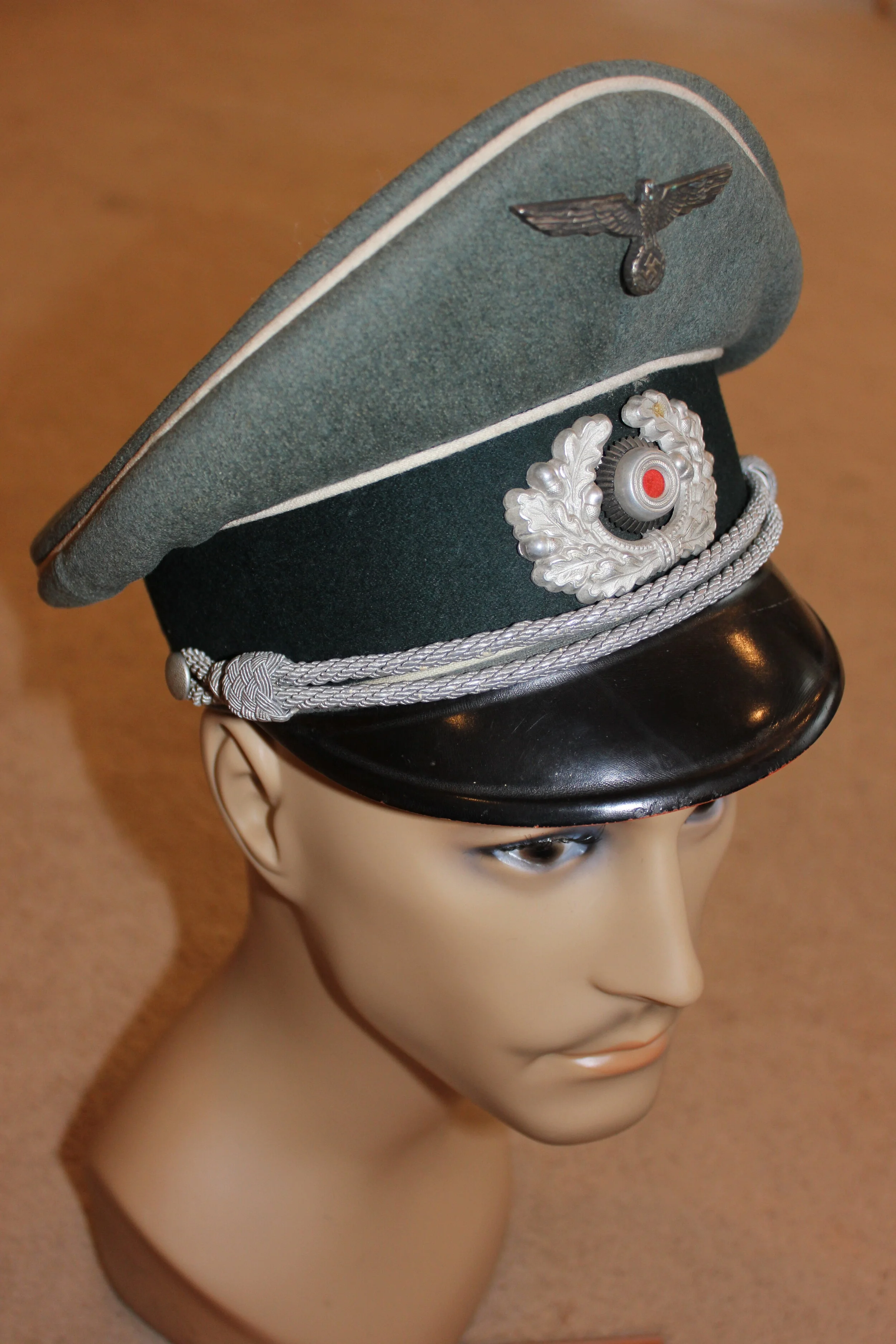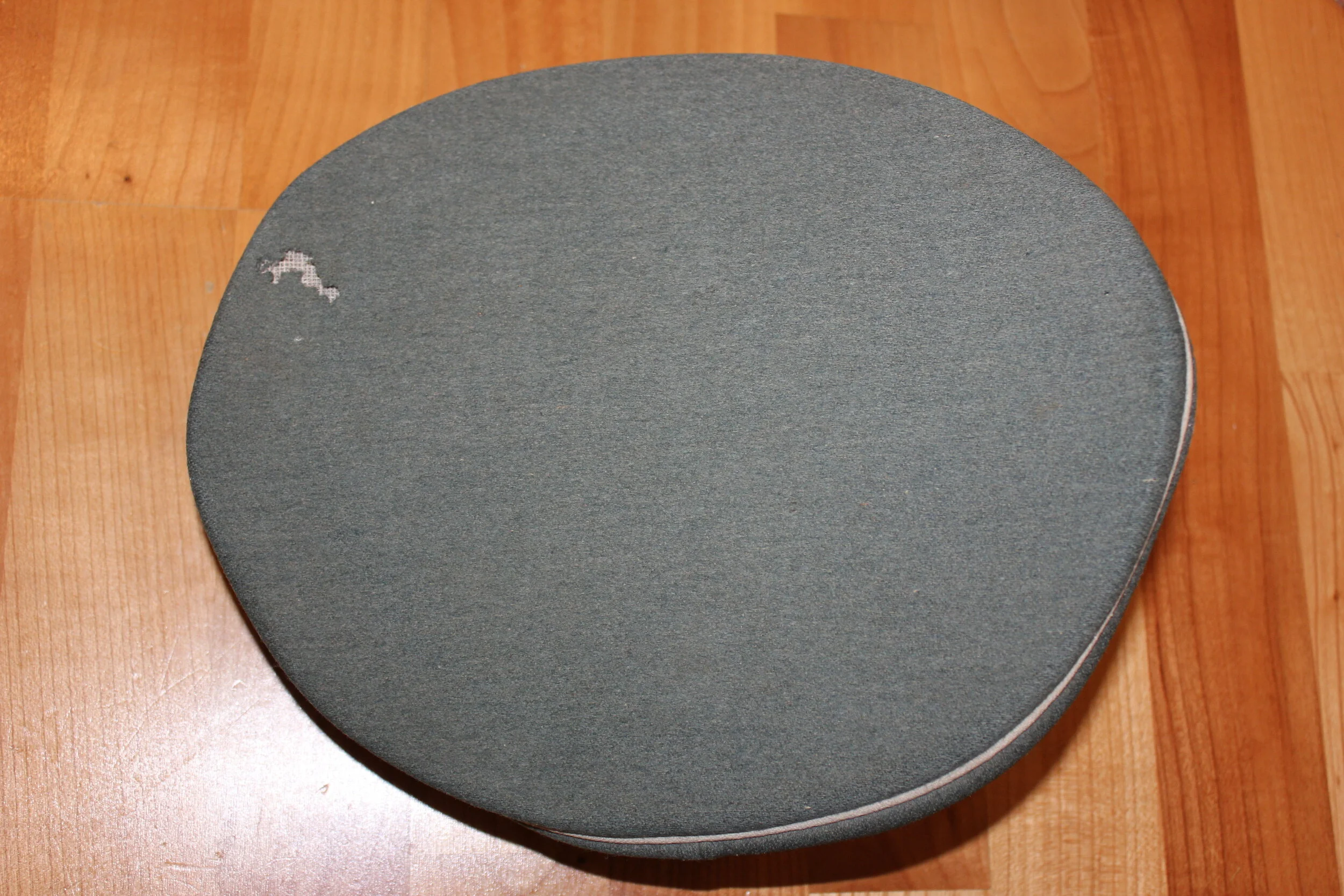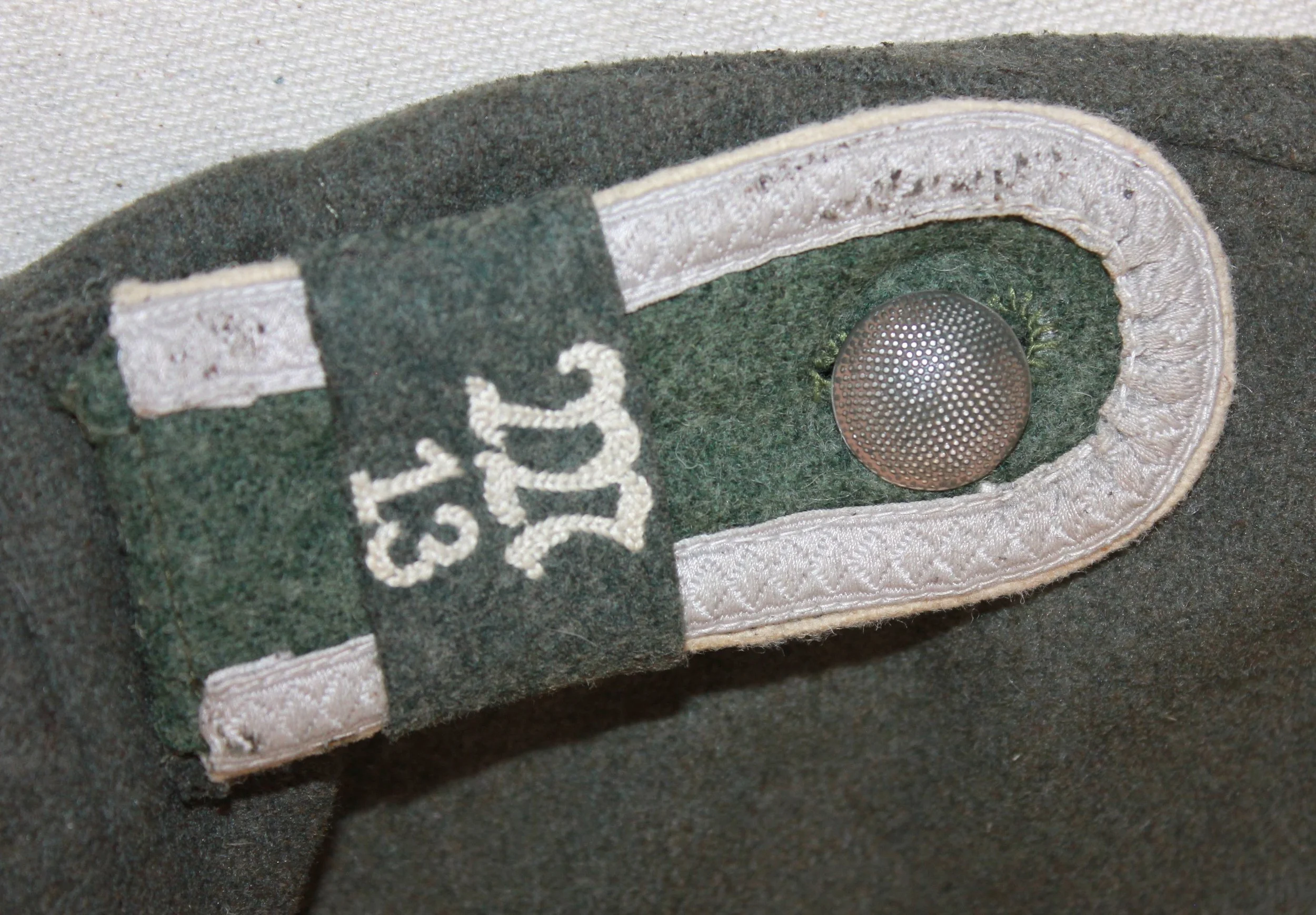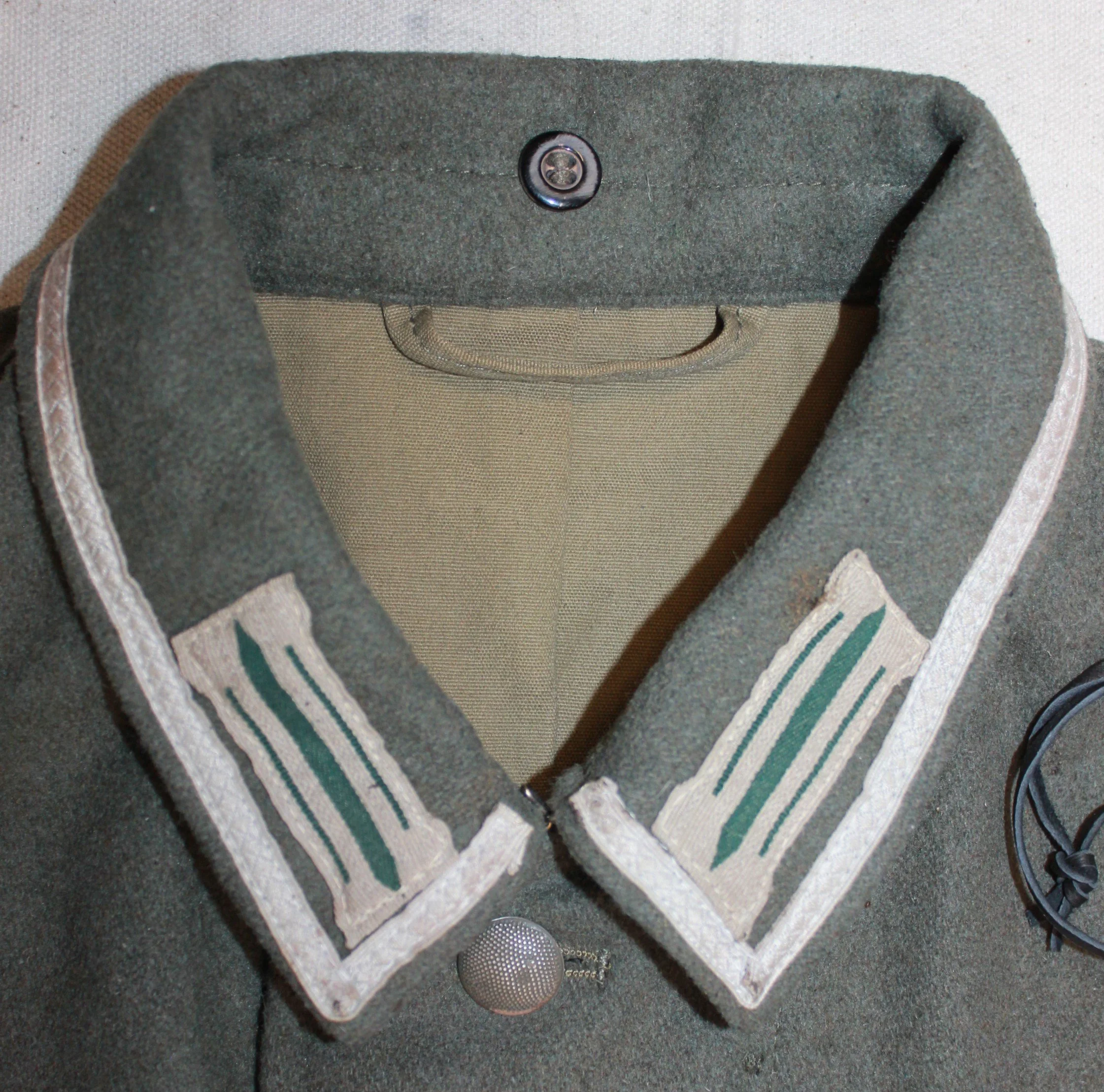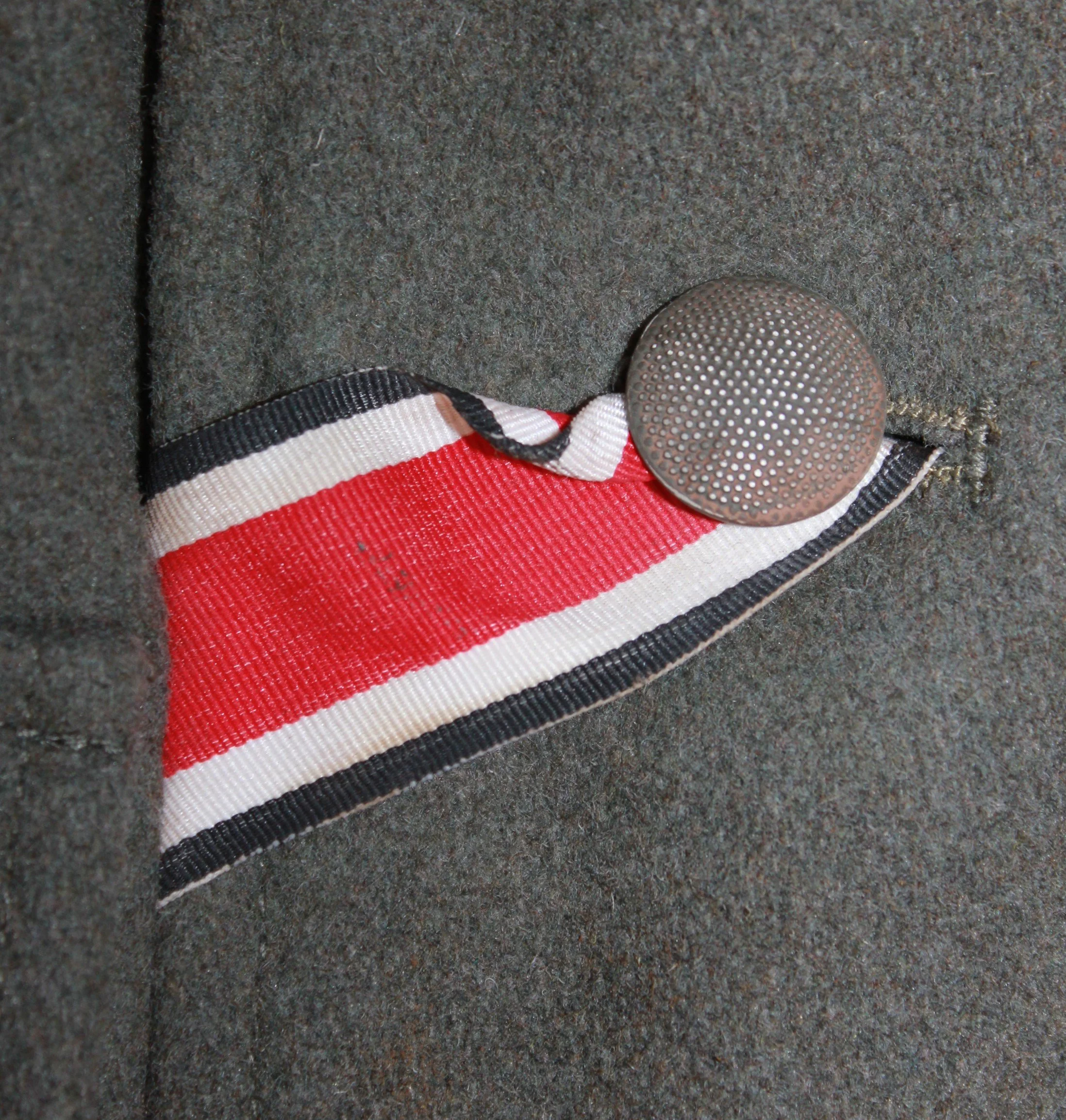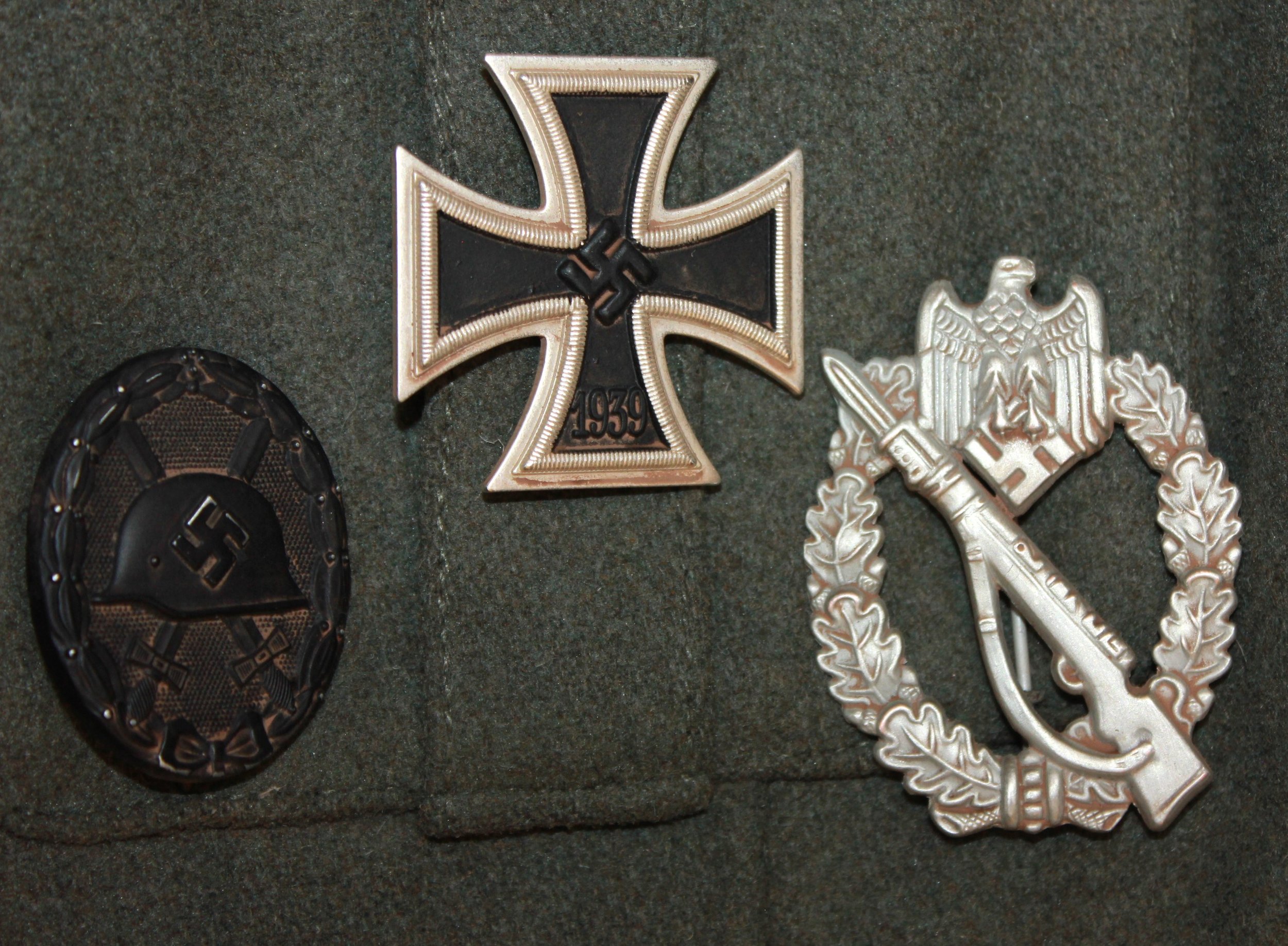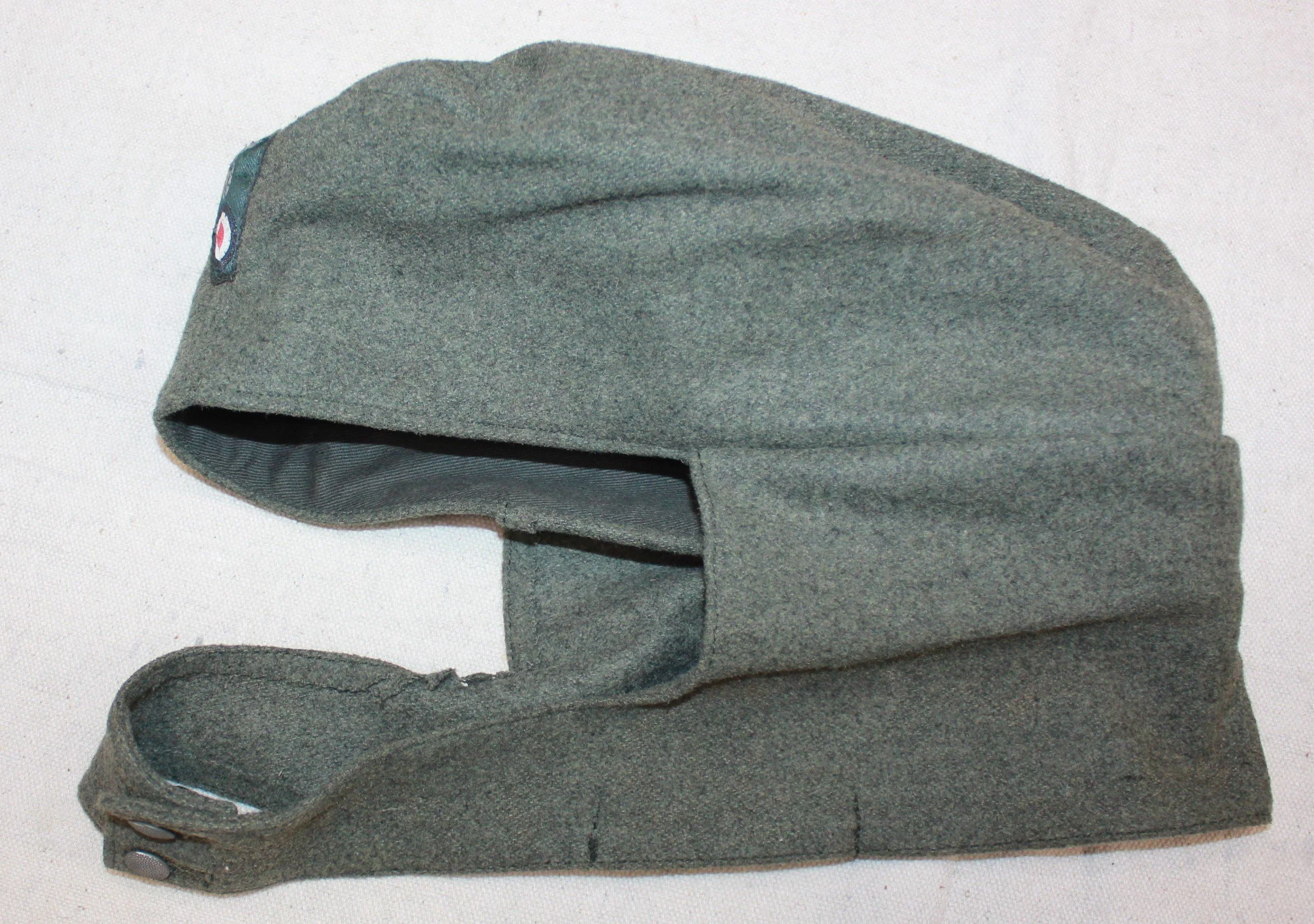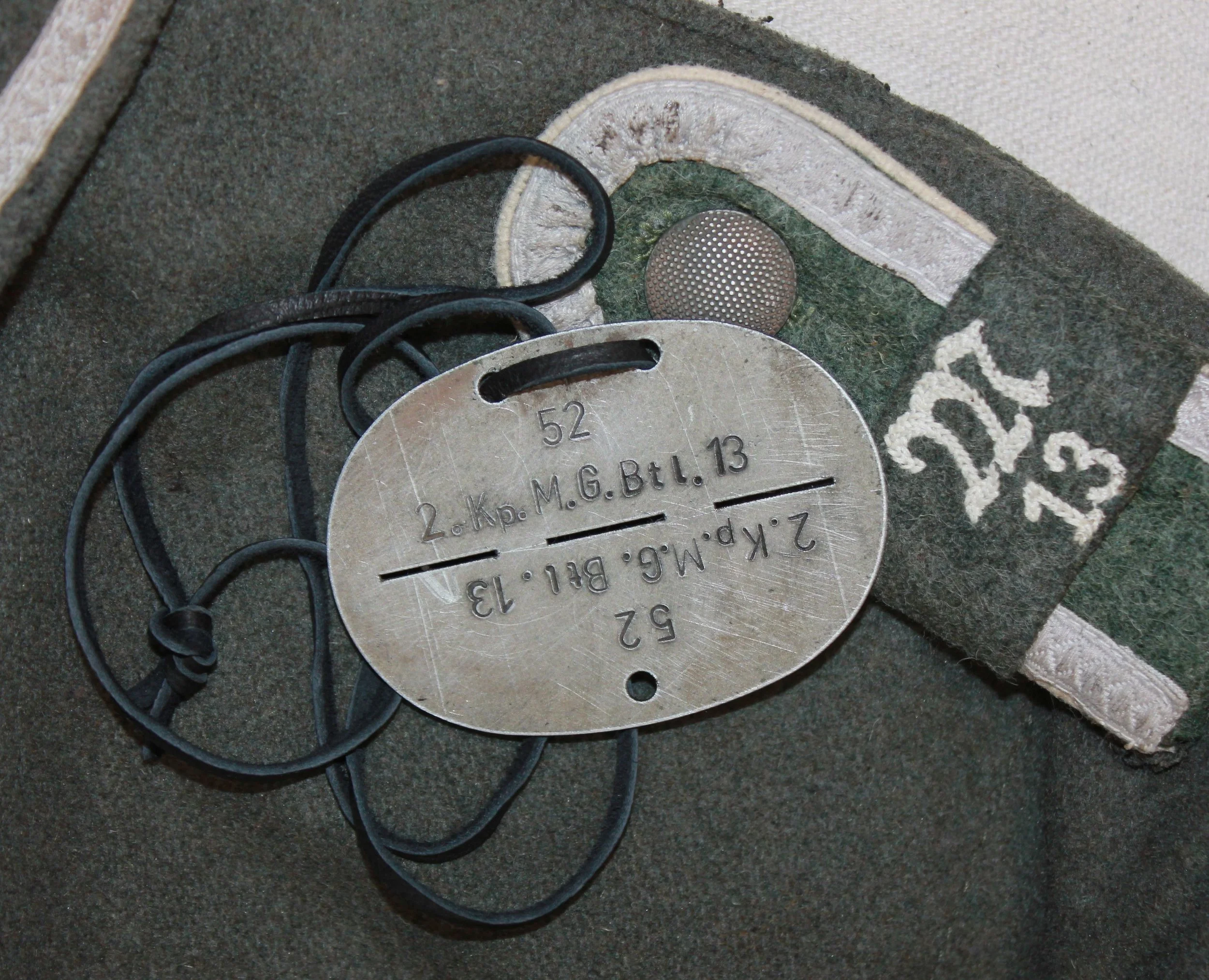Heer Infantry Machine Gun Battalions:
Gefreiter, Maschinengewehr Bataillon 3 (mot):
Activated in October of 1935 at Kruger Kaserne in Budingen, the Bataillon was originally part of Vehkreis IX. In 1939, it was transferred to Bitburg, part of Vehkreis XII, and guarded the border on the Siegfried Line facing France. The Bataillon went on to fight in France as part of the 16. Infantry Division (mot.).
Following the French Campaign, the division was reorganized during the summer into the 16. Panzer fought in Russia and ended up in Stalingrad, where it was destroyed.
As all Maschinengewehr Bataillon the 3rd was composed of Kompanie, with a Mortar, Panzerjager (Anti-tank), and a Stab (headquarters) Kompanie.
The Gefreiter wears the Feldbluse Model 1936 with sewn-in Shoulder Boards which are ciphered “M” indicating “Maschinengewehrn” and the Bataillons number chain-stitched in the white Waffenfarben of the Infantry. The uniform depicts the time following the fighting in France, where the Gefreiter has received a promotion from Schütze to Gefreiter, and before the troops went to Russia.
Unteroffizier, 4. Machinegewehr Bataillon:
Activated on 15 October 1935 at the Münseingen training, the battalion occupied the Westwall bunkers near the beautifully situated castle Sponeck, spending spent seven months on the Westwall operation and readiness in Waldkirch. On 9 February 1940, the battalion relocated to the training area at Grafenwoehr. After getting reorganized, the Bataillon was divided into 3 MG Kompanie with a heavy weapon and Krad Kompanie. Positioned back in the north of Germany, the Bataillon took part in the invasion of Denmark in April 1940.
Embarking on the steamers ‘Leunas’ and ‘Campinas,’ the unit shipped to Oslo and engaged in the battle for Norway from 28 April to 10 June 1940, usually broken into combat groups supporting other German units. On June 29, 1941, the battalion reached Kirkenes and became part of Gebirgs-Korps Norway commanded but General Eduard Dietl. The Korps crossed the Norwegian-Finnish border on 3 July 1941 and fought continually on the eastern front lines with the Finns against the Soviets.
By the Spring of 1944, the situation deteriorated with the Finnish and Soviet governments signing a truce in September, the provisions of which were the removal of all German forces from Finnish territory. The battalion retreated to Narvik and then south. In September of 1945, he was transported in two parts from Bretzenheim to POW facilities in France and Austria.
The Unteroffizier’s Heeres Dienstanzug M36 displays the prewar, cyphered, Schulterklappen as well as early pattern collar Litzen, both piped in white Waffenfarbe. He has been awarded both the Eisenes Kreuz I. u. II. Klassse for the leadership of his MG Zug. For walking out, he wears an enlisted Schirmmütz with trousers and Marchstiefel along with a cartridge belt with a buckle.
Scutze, Maschinengewehr-Bataillon 55:
Machineengewehr-Bataillon 55 was organized by renaming MG Bataillon 35 on 10 November 1938 in Horb. The Batailllon formed into 3. Kompanie armed with 2 cm anti-aircraft guns. The Batallion was subordinate to the Infanterie Division 25. In late August 1939, the Kompanie was made available individually to become the 3. or 4. Kompanie of Panzerjäger Batallion of Infanterie-Divisions. 1. Kompanie, under Major Weber, formed the 4. Kompanie Panzerjäger Bataillon 5 of Infanterie Division 5. I.D. 5 remained on the west front until the Battle of France and remained there on occupation duty until April 1941, when it moved to Ost Prussia to stage for its part in Operation Barbarossa. Fighting as part of the push towards Moscow, it held in place until relieved in 1942 and was pulled back for two months’ rest and refit in France. Returning to Russia if fought around Demjansk until redesignated a Jägerdivision.
Zugführer, Maschinengewehr (MG) Bataillon 6, 1940:
Maschinengewehr Bataillon 6 used its three MG-Kompanien (1-3 Kp) to support the Infanterie Batallion’s of the Infanterie Regiment. A Zug or Platoon, roughly, of 4 heavy machine guns (with their mounts) was attached to each Infanterie Kompanie.
At the beginning of the War, the MG-34 (carried in the light mode) was the standard Infantry Machine Gun of an Infanterie Zug. MG-Bataillon Zug guns were equipped with a stable tripod mount and optical sights to go with it, transforming the same MG-34 into a heavy, accurate-long-range machine gun.
Each “Zug” had a specialized cart that carried two MG-34s, a bunch of Ammo, and supporting equipment. Light trucks and Motorcycles provided mechanized transportation for the teams and their gear and weapons.
An MG bataillon also contained an 8cm Granatwerferzug (mortar platoon), PAK-Zug (light anti-tank platoon), Infanteriegeschutzzug with two 75mm howitzers, and even a Pionierzug (engineer platoon).
Maschinengewehr Bataillon 6 formed in Bamberg, Wehrkreis XIII in 1936, relocating to Coburg the same year, as part of Infanterie Division 17. The division took part in the Invasion of Poland and the fighting in Bzura, one of the few crisis points for the German Military in the Campaign. Reclassified as Kradschützen Bataillon 40. The Bataillon 40 became part of the new Infanterie Division 10 in 1943. A year later, the division was annihilated on the Ost Front in 1944, and few, if any, ever came home.
The Zugführer (or Platoon Commander) uniform, an officer pattern feldbluse following the Bataillon’s combat in Poland. For his leadership, he has been awarded the Eisernes Kreuz II. Klasse and the Infanteriesturm Abzeinchen in Silber. The MG ciphers mounted on the Infanterie white Waffenfarbe piped shoulder boards indicate the Bataillon’s organization around the heavy machine gun and the “6” numbers in the unit. This rare combat bluse is worn with Schirmütz, Stiefelhose, and officer Marchstiefel. When in action, he wore a Stahlhelm with a double decal, a double prong belt with a side arm on it, in a holster, and whatever other gear needed at the moment, perhaps field glasses.
Unteroffizier, Maschinengewher-Bataillon 13:
Das Maschinengewehr-Bataillon 13 was formed in November 1938 in Friedensstandort Saarlautern (Saarlouis), im Wehrkreis XII, as part of the III. / Infanterie-Regiment 70 but under the command of Heerestruppe of dem Generalkommando Saarpfalz. Das Bataillon was assigned duty on the Westwall in 1939, remaining there until February 1940 when it transferred to Magdeburg, in Wehrkreis XI, where it gained an additional MG-Schützen Kompanie along with the 4. Schweren Kompanie.
In April 1940, the Bataillon shipped out to Dänemark and then to Norway. From 1941 bis 1944, the Bataillon fought in Nordkarelien und Nordfinnland. Following the Finnish–Soviet armistice, the Bataillon was garrisoned in Narvik and then later in Oslo, where it remained until the end of the war. White chain-stitched Aufschiebenschalaufen or slip-on unit ciphers identify the Unteroffizier as a Bataillon member. These can be removed or rotated on the Schulterklappen for security measures.
The Heeres Dinestanzug Model 1940 has war period tress added to the collar and shoulder insignia along with standard BEVO national eagle and collar Litzen. His Feldmütz Model M42, a rare mid-war issue cap, places this uniform somewhere in the Finnish campaign or later. At a minimum, his rank places him in control of a Zug or three Maschinengewehrwagen 36.
His combat leadership has earned him the Eiserne Kreuze I. u. II. Klasse, the Infantrie Sturmabzeichen in Silber. He has been wounded at least once. An MG-Lafette 34 machine gun mount 34 was carried for each MG 34. Additionally, a Zwillingssockel 36 – pedestal mount 36 for two machine guns – was mounted on the Hinterwagen - rear wagon of the Maschinengewehrwagen 36 (If. 5). This could be used as an anti-aircraft weapon.






























